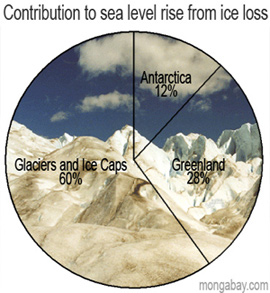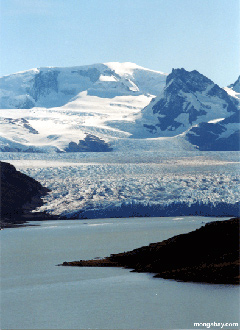Melting glaciers and ice cap will drive sea level rise
Melting glaciers and ice cap will drive sea level rise
mongabay.com
July 19, 2007
Melting glaciers and ice caps will contribute more to global sea level rise this century than the melting of the Greenland and Antarctic ice sheets, reports a study published in the current issue of Science.
Analyzing satellite, aircraft and ground-based data from glaciers, ice caps, the Greenland ice sheet, the West Antarctic ice sheet and the East Antarctic ice sheet, an international team of researchers found that about 60 percent of total global sea rise from ice loss can be attributed to glaciers and ice caps, 28 percent from Greenland, and 12 percent from Antarctica. The authors conclude that Greenland will not catch up to glaciers and ice caps in terms of sea level rise contributions until the end of the century.
“One reason for this study is the widely held view that the Greenland and Antarctic ice sheets will be the principal causes of sea-level rise,” said lead author Mark Meier of the University of Colorado at Boulder’s Institute of Arctic and Alpine Research (INSTAAR). “But we show that it is the glaciers and ice caps, not the two large ice sheets, that will be the big players in sea rise for at least the next few generations.”
 |
The researchers say the largest contribution comes from so-called “tidewater glaciers” that discharge icebergs directly into the ocean. Tidewater glaciers are undergoing rapid thinning, stretching and retreat, causing them to deliver increased amounts of ice into the world’s oceans.
“While this is a dynamic, complex process and does not seem to be a direct result of climate warming, it is likely that climate acts as a trigger to set off this dramatic response,” said CU-Boulder geology Professor Robert Anderson, a co-author and also an INSTAAR researcher.
The researchers estimated that accelerating melt of glaciers and ice caps could add 4 inches to 9.5 inches of additional sea level rise globally by 2100, projections that do not include the thermal expansion of warming ocean water, “which could potentially double those numbers.”
 |
“A one-foot sea-level rise typically causes a shoreline retreat of 100 feet or more, and about 100 million people now live within about three feet of sea level,” explained a statement from CU-Boulder.
“At the very least, our projections indicate that future sea-level rise may be larger than anticipated, and that the component due to glaciers and ice caps will continue to be substantial,” the researchers wrote.
Anderson said it was unlikely that much of Greenland’s ice sheet — which holds ice equivalent to a 23-foot rise in sea levels — would melt this century.
CITATION: “Glaciers Dominate Eustatic Sea-Level Rise in the 21st Century,” by M.F. Meier, M.B. Dyurgerov, U.K. Rick, S. O’Neel,W.T. Pfeffer, R.S. Anderson and S.P. Anderson at University of Colorado at Boulder in Boulder, CO; M.B. Dyurgerov at Stockholm University in Stockholm, Sweden; S. O’Neel at University of Alaska-Fairbanks in Fairbanks, AK; A.F. Glazovsky at Russian Academy of Sciences in Moscow, Russia. Science 20 Juy 2007.